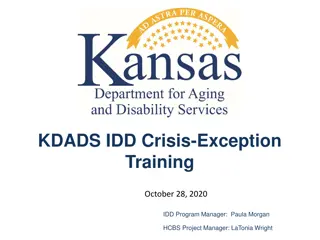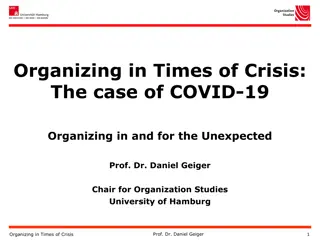Overview of Mobile Crisis Intervention Services and the Impact of COVID-19
Mobile Crisis Intervention Services (MCIS) in Connecticut provides crisis stabilization and hospital diversion for youth experiencing behavioral and mental health crises. Available for ages 0-17 and 18-year-olds in high school, MCIS offers intervention, referrals, and support to prevent future crises. Services are accessible by dialing 211. The program aims to bridge gaps in care and provide assistance until long-term treatment is established. MCIS assessments include risk evaluation, safety planning, and treatment recommendations. Services are voluntary and cost-free to families, with funding covering potential insurance costs. The program operates daily with mobile support and 24/7 phone access for assistance.
Download Presentation

Please find below an Image/Link to download the presentation.
The content on the website is provided AS IS for your information and personal use only. It may not be sold, licensed, or shared on other websites without obtaining consent from the author.If you encounter any issues during the download, it is possible that the publisher has removed the file from their server.
You are allowed to download the files provided on this website for personal or commercial use, subject to the condition that they are used lawfully. All files are the property of their respective owners.
The content on the website is provided AS IS for your information and personal use only. It may not be sold, licensed, or shared on other websites without obtaining consent from the author.
E N D
Presentation Transcript
An Introduction to Mobile Crisis Intervention Services OVERVIEW OF MCIS SERVICES & THE IMPACT OF COVID- 19 DECEMBER 9TH, 2020 EMILY MORSE, LCSW MCIS PROGRAM MANAGER
What is Mobile Crisis? Mobile Crisis is a statewide, voluntary crisis stabilization/hospital diversion program offered throughout the state of Connecticut. To access Mobile Crisis services, dial 211, press 1, then press 1 again. Alternate Phone Number for 211: 1-800-203-1234
Why call Mobile Crisis? To provide crisis intervention services for youth who are experiencing behavioral and/or mental health crises. To avoid youth having unnecessary assessments at the emergency department for behavioral health and mental health crises. Mobile Crisis can team with schools and other providers to address complex situations and make referrals for services in the community to prevent future crises. Mobile Crisis can bridge services until a youth is able to start long-term treatment when clinically appropriate.
Who does Mobile Crisis serve? Mobile Crisis is available for any youth 0- 17 years old (no minimum age) and 18 year olds who are still in high school/currently at the school in the state of CT who are experiencing a mental or behavioral health crisis. MOBILE CRISIS ATA GLANCE What constitutes a crisis ? The crisis is defined by the caller; however, we frequently respond to calls for suicidality, homicidality, self-injurious behaviors, disruptive and combative behaviors, and symptoms of anxiety and depression. Where are youth assessed?: Typically about half of our calls come from schools and the other half come from families directly. We can assess youth anywhere in the community as long as we have permission to be there. When can families receive services?: MCIS is mobile from 6am-10pm Monday-Friday and 1pm-10pm Saturday-Sunday. A clinician is available for phone support 24 hours a day/ 365 days per year. What is the cost for services? There is no out of pocket cost to families for MCIS services, regardless of if the family has insurance. MCIS attempts to obtain insurance information to bill insurance; however, if the claim is denied or if there is a co-pay, the MCIS grant covers the cost.
Mobile Crisis Assessments & Follow Up After a MCIS assessment: During a MCIS assessment: Follow-up telephone call to family. Follow-up calls to current providers, school, etc. (if releases were signed). Referral to treatment when needed. Bridging of care when appropriate (must maintain outpatient level of care). Gathering of background information from youth, guardians, and/or other involved parties. Risk assessment is conducted. Safety plan is created. Treatment recommendations are made.
Mobile Crisis is a voluntary service. Families can decline services at any time regardless if they made the initial 211 call. Assessments can take place anywhere in the community; however, MCIS needs permission from homeowners/renters to conduct assessments in their homes. Other Pertinent Information: On average, a full assessment takes about two hours. Mobile Crisis is an unlimited use service.
UCFS MCIS Program Structure Samantha Robinson, LCSW Director of Clinical Community Based Programs Emily Morse, LCSW Program Manager Jennifer Croce, LCSW Supervisor- Norwich Supervisor- Norwich Vernalisa Walton-Bogel, LCSW Lauren Whitmore, LCSW Crissy Waggoner Supervisor- Plainfield Project Assistant/Case Manager Clinicians/Liaisons FT Case Managers
PROACTIVE COMMUNITY INVOLVEMENT Members of Systems of Care collaboratives in both the NE and SE. Participation in: Community Coalition for Children (CCC) Eastern CT Suicide Advisory Board Juvenile Review Boards Client Care Teams (CCT) and Child and Family Team (CFT) meetings Human Anti-Trafficking Response Team Provide trainings and presentations on mental health QPR (Question, Persuade, and Refer) trainings to local entities including fire departments SBIRT (Screen to Brief Intervention, Referral to Treatment) Presentations to local high school students on suicide awareness and prevention and mental health Classroom de-escalation techniques Introduction to Child Trafficking in CT training Participating in community events including health fairs, open houses, etc. Provide support for schools and communities when there is an untimely death or community crisis.
Telehealth/telephonic assessments Call volume/referral source Impact on mobility and response time Acuity/Emergency Department referrals Impact of COVID- 19 on MCIS
DCF Benchmarks Response Time- 80% Benchmark Mobility- 90% Benchmark In SFY 2021 Q1 62.5% of all mobile responses achieved the 45 minute mark, compared to 82.9% of mobile responses in SFY 2020 Q1. The median response time for SFY 2021 Q1 was 35 minutes. In SFY 2021 Q1, the mobility rate for the Eastern Region was 81.0% compared to 89.7% for SFY 2020 Q1. *Change to mobility in starting Q2 2021
Impact of COVID- 19 on Call Volume Q1 2021 had a 27.7% decrease when compared to SFY 2020 Q1.
Referral Sources During Q1 2021 Referral Source: 73.4% - Self/Family 8.2% - Schools 8.2% - Other Community Provider Agency 4.3% - Psychiatric Hospital 2% - Foster Parent 2% - Physician- 2% 1% - Emergency Department- 1% .5% - Other Program within Agency .5% - Police- .5%
Referrals to the ED: Q4 2019-Q2 2021 Number of ED Referrals Per Quarter Percentage of Total Calls Referred to ED Per Quarter 30 25 9% # of Referrals 8% 20 7% 6% 15 5% 4% 10 3% 2% 5 1% 0% 0 Q4 2019Q1 2020 Q2 2020 Q3 2020 Q4 2020 Q1 2021Q2 2021 Q4 2019Q1 2020Q2 2020Q3 2020Q4 2020Q1 2021 Q2 2021
Was the youth admitted inpatient? 14 12 Outcome of ED Referrals Yes 10 No 8 Did not go to ED Unknown 6 Rec. Inpt. But did not go (no beds) 4 Referred Inpt; guardian declined 2 0 Q4 2019 Q1 2020Q2 2020Q3 2020Q4 2020 Q1 2021 Q2 2021
ANYQUESTIONS? Emily Morse, LCSW- 860-822-4796 / emorse@ucfs.org























